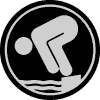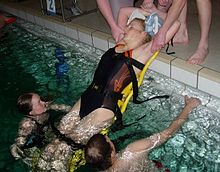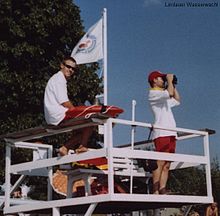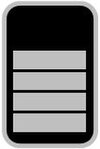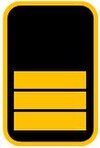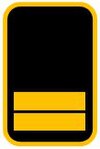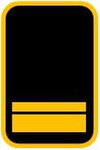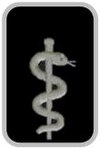Water watch
| Water watch | |
|---|---|
| legal form | Community of the German Red Cross |
| founding | February 7, 1883 in Regensburg |
| Seat | Berlin |
| Office | Berlin , Germany |
| motto | With safety on the water. |
| main emphasis | Swimming training, water rescue , reconnaissance, disaster control |
| Chair | Andreas Paatz, federal manager |
| Members | 140,000 |
| Website | www.drk.de/wasserwacht |
The water watch is a politically and denominationally independent community of the German Red Cross (DRK). Your task is to rescue people on, on and in the water . With a total of over 140,000 members, the organization is represented as an aid and water rescue organization in all regional associations of the German Red Cross. The water watch is mainly active near the coast and on inland waters. The members work voluntarily and in their free time for the water rescue service. The motto of the community is "With safety on the water".
As a community of the German Red Cross, the water rescue service is committed to the principles of the International Red Cross and Red Crescent Movement .
tasks
The main task of the water watch is the fight against drowning death and the implementation of the associated preventive measures.
In addition to this main task, the water watch has other tasks. One of them is the implementation of the water rescue service , as well as the education and training of suitable emergency services and members. It is particularly important to spread the knowledge and skills of swimming and lifeguarding among the population, especially among young people, in schools and associations. In the event of a disaster, it is important to set up, train and equip special units. In connection with the water rescue service, the participation in increasing safety on and in bodies of water (including waterways ) and in public pools is one of the other tasks of the water watch. Additional tasks are the search and rescue of drowned people and the participation in nature and water protection in accordance with the statutory provisions.
Bathing rules are of particular importance, especially in children's education . Members of the water rescue service's "Water Rescue Service " must regularly repeat the German lifeguard badge in silver and a first aid course .
In 2009, in Bavaria alone, the water rescue service obtained 17,768 early swimmers badges, 19,295 swimming badges ( DJSA and DSA ) and 7,936 lifeguard badges . In the same year as part of the water rescue service, 560 swimmers, 598 for surfers and sailors and 112 for boat crews were carried out throughout Bavaria. 48 resuscitations were also performed, 29 of which were successful. A rapid response group was requested 1,246 times .
history
From the foundation to the Second World War
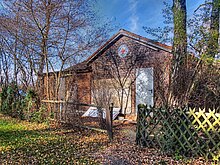
The Bavarian district town of Regensburg is considered the birthplace of the water rescue service in the DRK . There, during a flood of the Danube on February 7, 1883, Red Cross helpers were deployed for the first time in flood rescue. In the years that followed, so-called “medical and water weir columns” were built on the coast and inland waters . In 1888 a medical and water weir column was founded in Elbing (Prussia) . For the first time, from August 21, 1891, medical ships were made available in Mariaort near Regensburg to secure the Danube . In 1896 , water rescue stations were established for the first time on the large pre-alpine lakes in Germany, the Staffelsee , the Ammersee , the Chiemsee and the Bodensee .
In 1908, the water rescue service with a so-called defense tower was started in Berlin on Wannsee , at what was then Kaiser Wilhelm Tower , today's Grunewald Tower . Other rescue stations followed, first on the Schildhorn , then also near Pichelswerder and Papenberge. With the support of the Prussian Ministry of Spiritual, Educational and Medical Matters , the “Central Agency for Rescue Services in Inland and Coastal Waters” was founded on February 17, 1906. In the same year, both at the first meeting of the German Red Cross and at the first international Red Cross congress for rescue services in Frankfurt am Main, the water rescue service was described as a “real Red Cross task to be carried out as everywhere as possible”. At the same time in Munich, “precautions to rescue drowned people on rivers and lakes” were made by the medical column leader Freiherr Stromer von Reichenbach . With these resolutions and the increasing number of floods, the Prussian state association caused every local association to set up a water rescue unit.
In the south of Germany there were many cases of flooding at this time, and so the helpers often had to work for more than two days without interruption. In February 1923, the German Red Cross issued comprehensive service regulations for the water rescue service. The Red Cross community also received its own symbol: the lifebuoy with the Red Cross in the middle. This symbol is still valid today in a modified form. With the beginning of the Second World War , most of the lifeguards had to serve at the front, so that almost no water rescue station could be operated anymore.
After the Second World War
After the Second World War, like all other associations, the water watch was banned by the Allied military administration . But only two months after the collapse of the German Reich on May 27, 1945, the Bavarian Red Cross was given the task of resuming its work in the field of water rescue as a public corporation in view of the increasing number of drownings . Other state associations followed Bavaria's example and started the water rescue service again. The training initially focused on the swimming courses, as shortly after the war about 80 to 95 percent of the pupils and 51 percent of the students could not swim.
Only then could the training of lifeguards, managers and trainers begin. This was also necessary because in some federal states the number of drownings compared to the total deaths was 30 percent. In cooperation with other clubs and institutions, especially sports clubs, professional associations and municipalities , of course, many campaigns have been launched to reduce this number. In 1948, 720 lives were saved in Bavaria alone. In the course of time, new local groups were founded again and again. Due to the change in society towards more competitive and extreme sports , technology also had to be improved. New input materials, such as more modern motor lifeboats, were used for the water rescue service. Due to the accumulation of catastrophes in recent years, especially since the end of the Second World War, the establishment of disaster control units began. Together with other associations and the Conference of Ministers of Education and Cultural Affairs , the water watch established the Federal Association for the Promotion of Swimming Training to standardize swimming badges on August 24, 1998 . In September 2006 the water rescue service became an associated member of the international water rescue organization, the International Life Saving Federation .
Areas of training and duties
The water rescue service offers various training courses in order to fulfill its tasks. As part of the broader education , the water rescue service runs courses in swimming and lifeguarding, first aid and medical training . These can be visited by interested citizens for a fee according to official guidelines.
swim
Swimming courses for children and adults are offered in the swimming training area. The main task is to train non-swimmers to become swimmers (beginners' swimming courses) and to consolidate swimming skills through regular swimming training. As part of the general training of outsiders, the swimming instructors also carry out examinations for taking their swimming badges . Since the water rescue service is a member of the Federal Association for the Promotion of Swimming Training , these tests are carried out according to official guidelines and are uniform throughout Germany. As their first swimming badge, children, young people and adults can acquire the early swimmer badge (starfish, seahorse). After that, children, young people and adults can purchase the German swimming pass.
Lifeguard
In the courses of the training area lifesaving , participants will learn the dangers of schwimmerischen use, control measures for external and internal rescue, the correct use of the available tools, such as Gurtretter , lifebuoys , and knowledge of first aid. The courses end with the "German lifeguard badge of the water rescue service " in bronze, silver or gold. Various professional and voluntary activities require proof of this knowledge.
The junior water rescuer was developed for children and adolescents and represents the transition between the adolescent swimming badge and active use as a lifeguard.
medical corps
Almost all active helpers of the water rescue working in the water rescue service have completed the medical training of the German Red Cross consisting of the sections SAN A and SAN B.
Water rescue
The silver lifeguard badge is the minimum training for active lifeguards of the water rescue service . There is also training to become a lifeguard in the water rescue service and water rescuer (formerly SAN C water rescue service ). This qualification is a prerequisite for further training of the water rescue service : for example as a manager, as a rescue diver or guide of a motor lifeboat , or further training as a trainer.
Boat driver training
With larger bodies of water, it is not enough to just provide lifeguards for protection. Especially during regattas, sailing events or on the coast, it is important that rapid medical help is available in the event of accidents or capsizing of boats . Motor lifeboats are also often used to avoid swimming lifeguards, as this is often associated with a high risk for the forces deployed. Motor rescue boats of the water rescue service are usually equipped with outboard or inboard motors or modern water jet propulsion . Only trained lifeboat operators of the water rescue service are allowed to operate a lifeboat during duty. In addition to the sport boat license inland or lake , the training also includes training content specific to the water watch.
Diving
Operational divers of the water rescue service are needed to search, rescue or rescue casualties when lifeguards and motor lifeboats alone are no longer sufficient. In addition, operational divers are required to rescue goods, vehicles and rubbish . The recovery of bodies is one of the tasks of an application diver. Rescue divers can only be the physically and mentally fittest active helpers of the water rescue service. The training usually lasts one to two years. Every active rescue diver of the water rescue service undergoes the diving medical examination G31 every year and must prove at least ten compulsory dives with a total of at least 300 minutes.
Nature and water protection
The main task of this training area is nature and water protection . Particular emphasis is placed on educating young people and on public relations work. The tasks include:
- Implementation of nature protection strips
- Practical nature protection, for example by participating in projects of the respective state environmental authorities
- Maintenance of protected landscape components
- Organization and implementation of advanced training courses
- Participation in the nature protection watch of the district offices
Executive and managerial training
Managers are in use responsible for the management of units and sub-units, while line forces, for example, conduct a water rescue community. The training is based on the guidelines for management and management training of the DRK, which is based on a modular structure. Particularly in the case of disasters and major loss events, it is often necessary to work with other aid organizations, such as the fire brigades or the technical relief organization (THW). It is therefore important to have a uniform division of managers across the organization. For this reason, the managers trained at the water rescue service are divided into troop , group and platoon leaders .
Advanced training
For trained emergency workers, managers, executives (e.g. board members) or trainers, advanced training courses are offered at regular intervals in order to expand or refresh their level of knowledge.
Areas of application
Ambulance service
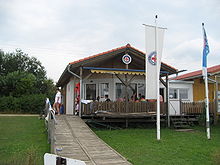
An important area of application is the rescue service on bodies of water , the coast and in indoor and outdoor swimming pools . The emergency services are often stationed in a water rescue station and are therefore quickly ready to provide assistance in the event of an accident. The ambulance service is mainly carried out on a private or public basis.
Rapid Response Groups (SEG)
To carry out the water rescue service, the water watch operates so-called Rapid Response Groups (SEG). These are composed of emergency services trained for the water rescue service who are alerted via radio receivers and drive together from the rescue station to the scene of the incident. The minimum qualification for members of rapid response groups is training as a water rescuer in the water rescue service. As a rule, however, the emergency services have more extensive training such as rescue divers, lifeboat drivers or paramedics . According to its own information, the water rescue service provides around 50 percent of all water rescue services in Germany.
The rapid response groups usually consist of at least one diving team , a boat squad and a leader of the rapid response water rescue group or group leader . If several rapid water rescue teams are deployed, they are led by a water rescue team leader or platoon leader.
Rapid response groups are usually equipped with minibuses as emergency vehicles , motor lifeboats, medical emergency equipment for the rescue service and special equipment for water rescue ( ABC diving equipment , including a diving mask , snorkel , diving fins ), water- saving equipment (e.g. life buoys , life bags , ice rescue sledges ) .
Civil protection
As an aid organization, the Wasserwacht actively participates in disaster control of the federal states and the federal government. As part of the strength and equipment verification , the individual association levels provide disaster control units to ward off the effects of disasters, such as water rescue groups and water rescue trains (WRZ). The water rescue service is currently also setting up flood rescue trains (HRZ) that can be deployed nationwide in the event of major disasters. The water rescue trains are often set up together with the German Life Saving Society (DLRG) for better coordination between the emergency services . A water rescue train consists of at least one leadership team and two water rescue groups. Often different specialist groups are assigned to the water rescue train, these can be:
- Technology / logistics
- care, support
- Environmental hazards
- medical corps
- Helicopter-based water rescue
These specialist groups support the water rescue groups, which in turn consist of at least one diving squad and a boat squad .
The air rescuers of the water rescue service represent a new kind of cross-organizational deployment concept. This was developed by the Bavarian State Association in cooperation with the German Armed Forces on the basis of experience with the floods in recent years . In the event of a flood, the specially trained water rescue forces manned helicopters from the German armed forces, as well as the police and other operators, and can rescue people threatened by the water with the help of a winch.
construction
According to the federal structure of the DRK, the federal association is divided into 19 regional associations, which are further subdivided into district associations (only in Bavaria), district water guards and local groups or local associations. A local group can optionally have one or more bases. A base is managed by a base manager. In individual regional associations there are also other special forms due to the history of the origins of the local water watch. For example, in individual cases the water watch is assigned to the standby as a specialist service or is set up at the district level instead of the local group level. Committee meetings take place regularly at the various levels and an honorary leader is elected (local group, district, district, state, federal management). At the federal and mostly also state level, the Red Cross provides a full-time employee for the water rescue service.
federal Association
Election period 2017–2021: Federal head of the water rescue service is Andreas Paatz (State Association Berlin), Deputies are Katy Völker and Gordon Wenzek (State Association Berlin / State Association North Rhine), Technical Director is Steffen Lensing (State Association Hesse), Deputy Technical Director is Patricia Behrend (State Association Berlin ).
Federal Commissioner for the Water Rescue
- Federal Commissioner for Helicopter-Assisted Water Rescue (HGWR): Stefan Mendl (LV Bayern)
- Federal Commissioner for Lifeguarding: Philipp Schöne (LV Berlin)
- Federal Commissioner for Boat Service: Martin Stange (LV Thuringia)
- Federal Commissioner for Lifeguards in the Bundeswehr: Claus Hieke (LV Bayern)
- Federal Commissioner for Occupational Safety: Katy Völker (LV Berlin)
- Federal Commissioner for Disaster Management: Andreas Geuther (LV Bayern)
- Federal Commissioner for Swimming: NN
- Federal Commissioner for Diving: NN
- Federal Commissioner for Water Rescue / River Rescue: Johannes Neumann (LV Oldenburg)
- Federal doctor: Martin Bauer (LV Sachsen)
- Disciplinary officer of the federal management: Andreas Paatz
Former federal leaders
- 1993-2008: Christoph Franzeck
- 2008–2009: Andreas Geuther Head; The deputies were Andreas Paatz and Michael Birkner
- 2009–2013: Stephan Goßner; Deputy was u. a. Andreas Paatz
- 2013–2017: Alexander Radwan ; The deputies were Andreas Paatz and Markus Ostermeier
- from 2017: Andreas Paatz; Deputy Katy Völker; Deputy Gordon Wenzek (from 2018)
Regional associations
The German Red Cross and consequently the water rescue service are divided into 19 regional associations. These largely correspond to the German federal states . The exceptions are:
- Baden and Baden-Württemberg are separate state associations
- North Rhine-Westphalia is divided into the state associations of North Rhine and Westphalia-Lippe
- the Oldenburger Land region , the former state of Oldenburg , is its own regional association
Bavaria is a special form of regional associations, since the individual structures are not legally independent registered associations, but part of the Bavarian Red Cross, which is a public corporation .
District Associations
The district associations only exist in Bavaria. They are the sponsors and organizers of various training programs in which the number of participants is too small for training at the district or local association level. Outside of Bavaria, this is then the task of the regional associations. The Bavarian district associations are:
- Upper Bavaria
- Upper and Middle Franconia
- Lower Bavaria-Upper Palatinate
- Swabia
- Lower Franconia
District associations and district water guards
A district association or a district water watch (formerly also known as a department) is the connection between the individual local groups in a district . Most of the training courses are held at the district level that would not be affordable for the local groups because of the insufficient number of participants. The disaster control units are also set up at the district or district level.
Local groups
The local groups are the basis of the work of the water watch. They carry out the water rescue service and training in swimming, lifeguarding, first aid and nature conservation. One or more support points can be attached to a local group. Support points are small locations that are not legally independent due to a lack of staff on the executive board.
The local group is headed by a board that is elected by the general assembly for four years. Every member older than 16 years has the active right to vote , adult members also have the right to stand as a candidate . The board of directors must at least consist of a chairman , a technical director and the youth leader . The technical director, who is responsible for equipping and training the members, takes over the chairman's duties if no deputy chairman has been elected. Mostly there are also other board members, such as the cashier , the secretary or authorized representative, who are responsible for a certain department.
Competitions
Lifeguard competitions are held at all levels of the lifeguard service . In addition to swimming skills, skills in first aid (theory and practice), water watch knowledge and nature conservation are tested. The competitions are for adults and teenagers. The youth competitions are held in three age groups: Level I (from 8 to 12 years), Level II (from 11 to 13 years) and Level III (from 14 to 16 years). The minimum age for adult competitions is 16 years.
Water watch youth
As in many other organizations, active youth work is very important in the water watch . In doing so, they not only follow the slogan “Today's youth are tomorrow's emergency services”, but also include children and young people in active service within the framework of the restrictions of the Youth Protection Act . The water rescue youth is heard no independent organization, but, as is the willingness to youth , the German Red Cross Youth (JRK), the Child and Youth Association of the German Red Cross.
In the water rescue service there is a youth leader at each level of the association , who is elected by the children and young people and who represents the water rescue service youth on the board . The respective group leaders in the local group are also elected by the youth group . The youth leaders and group leaders are elected in a secret ballot by the over ten-year-old members of the water rescue youth. There is a separate order for the water watch youth, the youth order, which is part of the order for the water watch .
Regulations
The supreme rule for the water watch is the order of the water watch . The latest regulation is the water rescue service regulation of October 9, 2014. This nationwide uniform regulation regulates the water rescue service of the water rescue service. It distinguishes, for example, the various emergency services, operational activities (security service, rapid response group, disaster control) and types of service (service at guard stations, boat service, diving service). However, many of the rules are very general, and so there are additional rules for each national association.
In addition to the regulations and service regulations, each training area has its own regulations, for example the various training and examination regulations (APV). Further regulations that apply to the water watch include the rules for commendations, complaints and disciplinary procedures of the communities and the uniform regulations for the communities on readiness and water watch.
Special position for Bavaria
In addition to the regulations, there is also the service regulation for the water rescue service of the Bavarian Red Cross in the version of January 1, 2005. This regulation , which is based on the regulation for the water rescue service, regulates the types of members, training courses and training areas and specialist services. In Bavaria , for example, there is the current version of the water watch, dated May 1, 2009. The rules regulate the nature, tasks, structure and structure of the water watch. The Bavarian version also includes youth regulations .
Service badge
regulation
The latest version of the "Uniforms regulation for the communities on readiness and water watch" was issued by the Presidium of the DRK and the Presidential Council on November 24, 2016 and updated again in 2017. A new service badge regulation was issued in March 2018. The functions are explicitly used in male and female forms, even if it is not mentioned.
A distinction is made between general uniforms and operational clothing.
Service badge
No shoulder flap or shoulder strap is permitted for uniforms, but there may be deviations in federal states.
At the same time, the service badge is not to be equated with the function in the emergency service.
Operations / managers
Management forces
to be borne after confirmed election / appointment
Similar organizations
In Germany, in addition to the water rescue service , the Deutsche Lebens-Rettungs-Gesellschaft (DLRG) , the fire services , the Arbeiter-Samariter-Bund (ASB) and the Technische Hilfswerk (THW) are active in water rescue.
In Switzerland there is the Swiss Lifesaving Society (SLRG) and in Austria, among others, the Austrian Water Rescue (ÖWR) and the water rescue of the Austrian Workers' Samaritan Association . All of these organizations pursue the same goals and, like the water rescue service, work on a voluntary and non-profit basis.
In Australia, the USA and, for example, Greece, however, there is no such structure. Most of the lifeguards here work full-time and are paid for their work. But there are also lifeguards there who voluntarily ensure water safety. Similarly, there are privately organized lifeguards in Germany (for example on Sylt) who are paid for their work.
literature
- Jürgen Weigel: 100 years of organized water rescue in Berlin . 1st edition. Kupfergraben-Verlag, Berlin 2002, ISBN 3-89181-012-1 .
- Peter A. Fischer, Thilo Künneth, Alfons Vorderauer: Pocket book for water rescuers: Advice for training and practice . Ed .: Wasserwacht. Ecomed, Landsberg / Lech 2009, ISBN 978-3-609-68739-1 .
Web links
- DRK water watch The main address of the DRK water watch. The state, district and district water guards and the individual local groups can be reached at this address.
Individual evidence
- ↑ a b Wasserwacht Deutschland - Rescue in the water - DRK eV German Red Cross, accessed on February 22, 2019 .
- ↑ a b ( page no longer available , search in web archives ) (as of 2009). Retrieved July 3, 2013
- ^ History of the water watch after the Second World War ( Memento from March 20, 2015 in the Internet Archive )
- ↑ Service regulations for the water rescue service (PDF file; 88 kB), s. Section 4
- ↑ New federal commissioner for water rescuers and flowing water rescuers. Retrieved February 22, 2019 .
- ↑ Wasserwacht Wolfratshausen accessed on November 19, 2018
- ↑ Wasserwacht Sachsen accessed on November 19, 2018
- ↑ Wasserwacht accessed online on Nov. 19, 2018
- ↑ German Red Cross e. V .: Service regulation water watch . Ed .: German Red Cross e. V. October 9, 2014, p. 16 ( drk.de [PDF]).
- ↑ Service badge regulation 2018 on DRK.de , accessed on November 21, 2018






